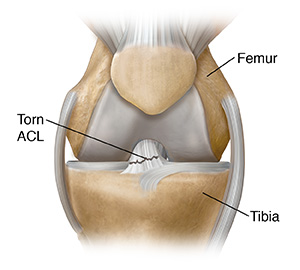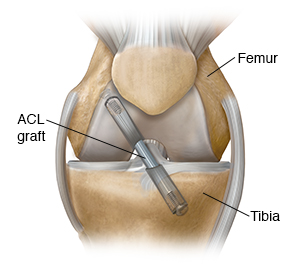Surgery for Anterior Cruciate Ligament (ACL) Injury
The ACL (anterior cruciate ligament) is a band of tough, fibrous tissue that helps stabilize the knee. Injury to this ligament often happens when the knee is forced beyond its normal range of motion. This can stretch or tear the ligament, much like the fibers of a rope coming apart. Both surgical and nonsurgical treatments have been used to recover from an ACL tear. Several types of surgery are available based on you and your healthcare provider's preferences, as well as other factors. Some surgeons will operate soon after an ACL tear. Others prefer several weeks of physical therapy first. There are also different anesthesia choices available.

Preparing for surgery
Do's and don'ts:
-
Stop taking aspirin and other blood-thinning medicines 7 or more days before surgery, as advised by your healthcare provider.
-
Arrange to get crutches to use during recovery. Get instructions on the correct way to use crutches before surgery.
-
Follow any directions you are given for not eating or drinking before surgery.
-
Arrange for an adult to drive you home after surgery.
During surgery
The most common type of surgery for an ACL injury is reconstruction. Several types of surgeries are used:
-
Patellar tendon graft. This uses a piece of your own patellar tendon between the kneecap and tibia.
-
Quadriceps tendon graft. This uses a piece of your own quadriceps tendon between the quadriceps muscle and the kneecap.
-
Hamstring tendon graft. This uses a piece of your own hamstring tendon between the hamstring muscle and the tibia.
-
A cadaver (allograft) tendon graft. This uses any one of several tendons from a cadaver.
To rebuild and repair your ACL injury, your surgeon may do open surgery or arthroscopy. It will depend upon the extent of repair needed. There is often less pain and faster healing using the arthroscopy method. During arthroscopy, a long, thin tube with a tiny camera is inserted into the knee joint. This lets your surgeon see inside the joint. Tools inserted through small incisions are used to fix the joint. Open surgery may be needed for more extensive repair.

After surgery
Here is what to expect:
-
You’ll be taken to the postanesthesia care unit (PACU) to be closely watched as you wake up from surgery. You’ll have ice on your knee to prevent swelling. Your leg may be in a brace.
-
You may get a continuous cooling machine to ease swelling and pain.
-
You may get medicines to reduce pain and swelling. Take these as prescribed by your provider.
-
Depending on the procedure, physical therapy may begin shortly after surgery. This may include light exercises. In some cases, you may use a CPM (continuous passive motion) machine for a time. This machine flexes and extends the knee, keeping it from getting stiff.
-
You can often go home the same day as surgery. Arrange to have an adult family member or friend give you a ride.
Online Medical Reviewer:
Rahul Banerjee MD
Online Medical Reviewer:
Raymond Turley Jr PA-C
Online Medical Reviewer:
Rita Sather RN
Date Last Reviewed:
4/1/2024
© 2000-2025 The StayWell Company, LLC. All rights reserved. This information is not intended as a substitute for professional medical care. Always follow your healthcare professional's instructions.